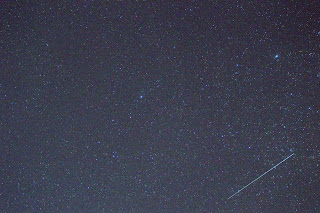August 30th 2125 GMT
The sky was covered by about 80% of cloud but I’d waited
what seemed like years since I had been out. I took some close-ups with my DSLR
at 300mm of the central part of Cassiopeia,
One of the frames caught a meteor.
I also aimed at the Andromeda
Galaxy (M31) but think I missed it. Thought wrong but the result was hardly a classic.
I saw a meteor of about magnitude 2 at 2140 GMT. It flashed
towards Cassiopeia from the direction of Cygnus so may well have been a Kappa
Cygnid.
August 25th 2230 GMT
Conditions were rather poor and I bin scanned the Moon through moving cloud. I was able to see most features, such as the "seas" and Tycho's rays were dominating the moonscape, as expected. Grimaldi stood out, even though it was near the lunar limb and Plato showed well, too.
August 25th 0800 GMT
The Sun was quiet in hydrogen alpha light but it was nice to
photograph it again.
August 24th 0715 GMT
The Sun was quiet in hydrogen alpha light and I was not able
to grab a photo before cloud rolled in.
August 21st 2200 GMT
It was late, so I just did a quick session. I tried a few
frames of the Moon with my DSLR.
I then tried using some background objects to align the Moon
with Mars and Saturn for a possible conjunction shot.
Moon with Saturn:
The Mars shot did not work.
Moon with Saturn:
The Mars shot did not work.
August 16th 2030 GMT
My original intention was to snap the Moon using the Bresser
Electronic Eyepiece after some full disc shots with the DSLR. Unfortunately,
Sharpcap kept crashing with the Electronic Eyepiece, so I just used my DSLR to
catch the full disc of the Moon. I used 1.54m focal length, ISO 6400 and 1/4000
second exposure.
August 13th 2100 GMT
I set another camera trap for the Perseids, aimed at
Cassiopeia.
August 13th 1540 GMT
The Sun was even quieter than it had been recently.
August 11th 0650 GMT
August 10th 2110 GMT
As Jupiter was low, I caught some tree branches with the background stars.
My shots were out of focus but I caught 4 meteors on camera.
August 7th 1210 GMT
August 6th 1050 GMT
August 5th 1020 GMT
August 5th 0030 GMT
Mars was well-placed, not just at a high elevation (well
higher than 2/3 nights ago) and also in a good position to view from my back
garden. Unfortunately, it showed little detail visually, so was quite
disappointing. As cloud and moonlight were encroaching and my camera was full
of attempts to catch meteors, I decided to call it a night.
August 5th 2305 GMT
August 4th 2245 GMT
August 4th 2225 GMT
At about 2246 GMT, I caught one.
Make that two, 30 seconds later.
At 2302 GMT. I caught a faint sporadic meteor.
At 2321, I caught another Perseid.
As a by-product of my meteor imaging, I stacked 383 images to produce an image of Cassiopeia and the Perseus Double Cluster.
At 2321, I caught another Perseid.
As a by-product of my meteor imaging, I stacked 383 images to produce an image of Cassiopeia and the Perseus Double Cluster.
August 4th 2115 GMT
Jupiter looked great, visually. I tried to get focus using
the Bresser Electronic Eyepiece but really needed to wait until the Moon was
around for a focus target.
I took some snaps of Jupiter and Saturn with my Mak and
DSLR. I caught some hint of the cloud belts of Jupiter.
All four Galilean moons were visible.
August 3rd 1215 GMT
I was pleased to see the Sun in a clear sky, as the weather
forecast had suggested otherwise. There seemed to be some activity near the
limbs, so I snapped in hope!
August 2nd 2115 GMT
As it was quite late and I had work the next day, I decided
to have a quick look at the planets. I took some afocal shots with my DSLR,
just in case I could see something "on film". I started with the Mak at 48x
magnification. Although experience had suggested that I would get better views
at much higher magnification, the air was not stable and the images were
“dancing”.
Jupiter showed a surprising amount of detail, showing polar
shading as well as the cloud belts. I only caught a hint of the cloud belts on camera.
Saturn’s rings looked great, although I could not make out
the Cassini Division. I could see some surface shading. Not a great photo, though.
Finally, Mars suggested that the worst of the storm was
over, as I could see some green patches, once thought to be vegetation. I was
also amazed that it was noticeably brighter than Jupiter and its disc was
large. I thought it would look great at one o’clock but I had work the next
day.
August 2nd 1035 GMT
I processed another frame.
August 2nd 0600 GMT
I snapped a waning gibbous moon with my DSLR. Unfortunately, all frames were over-exposed.








































No comments:
Post a Comment